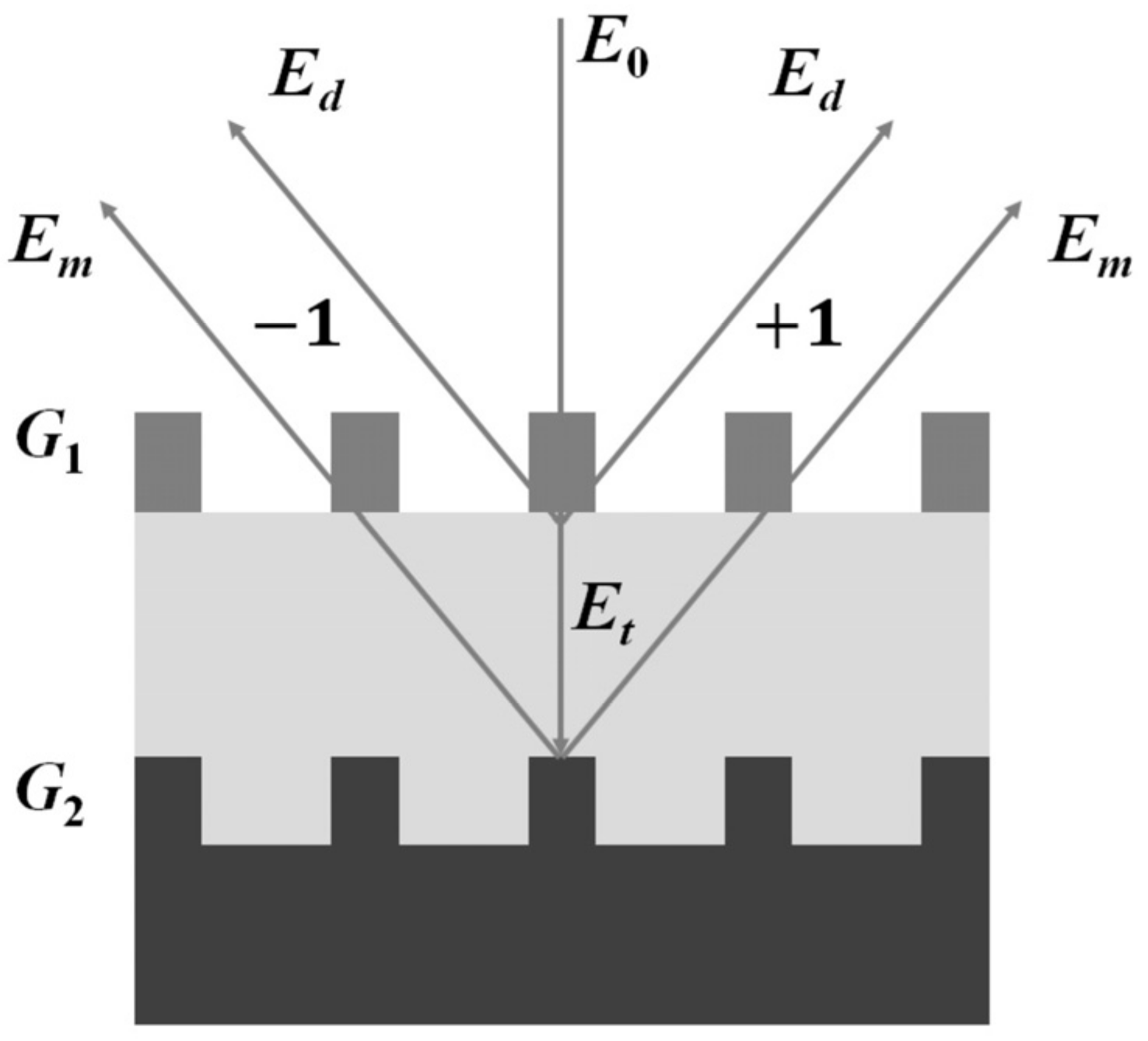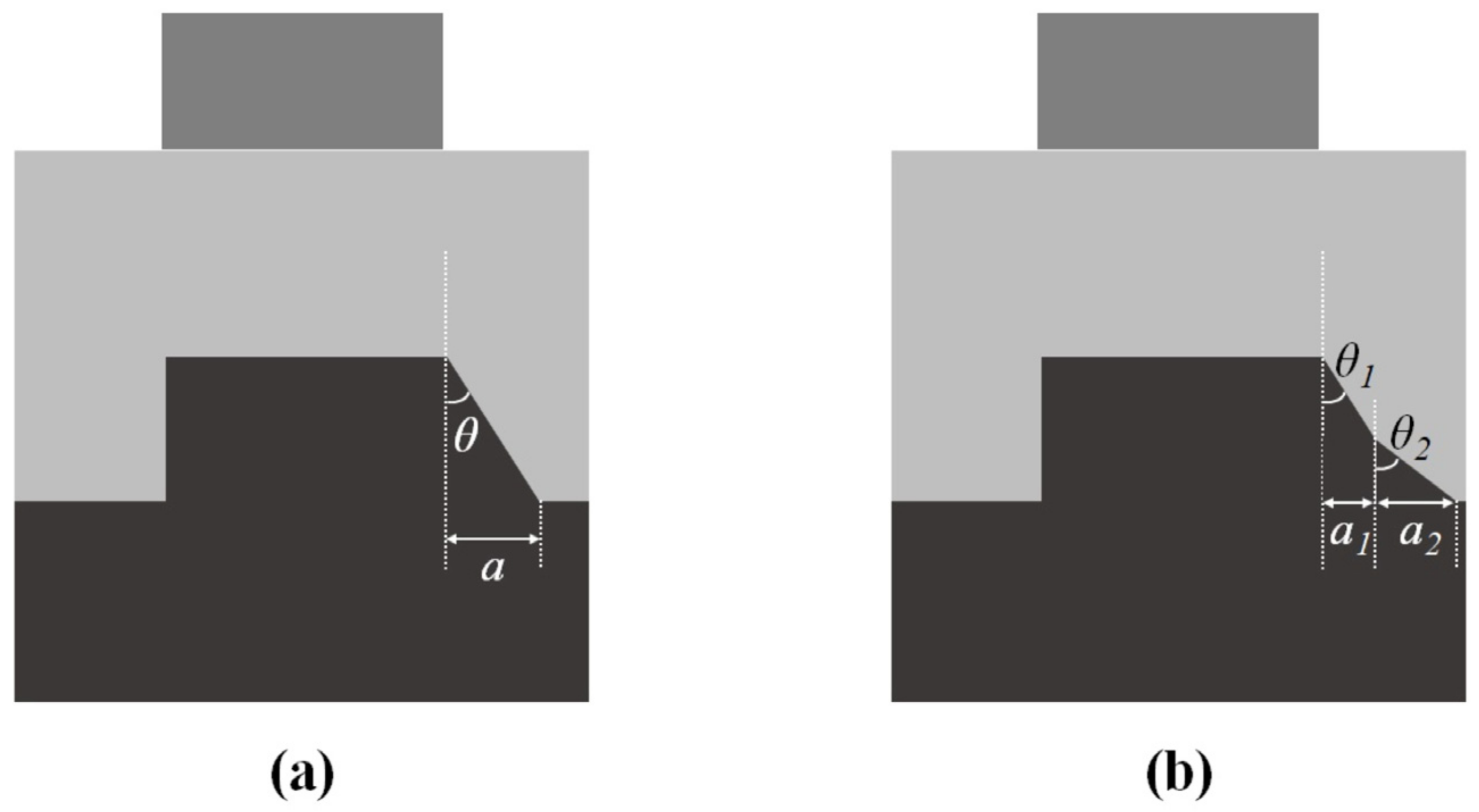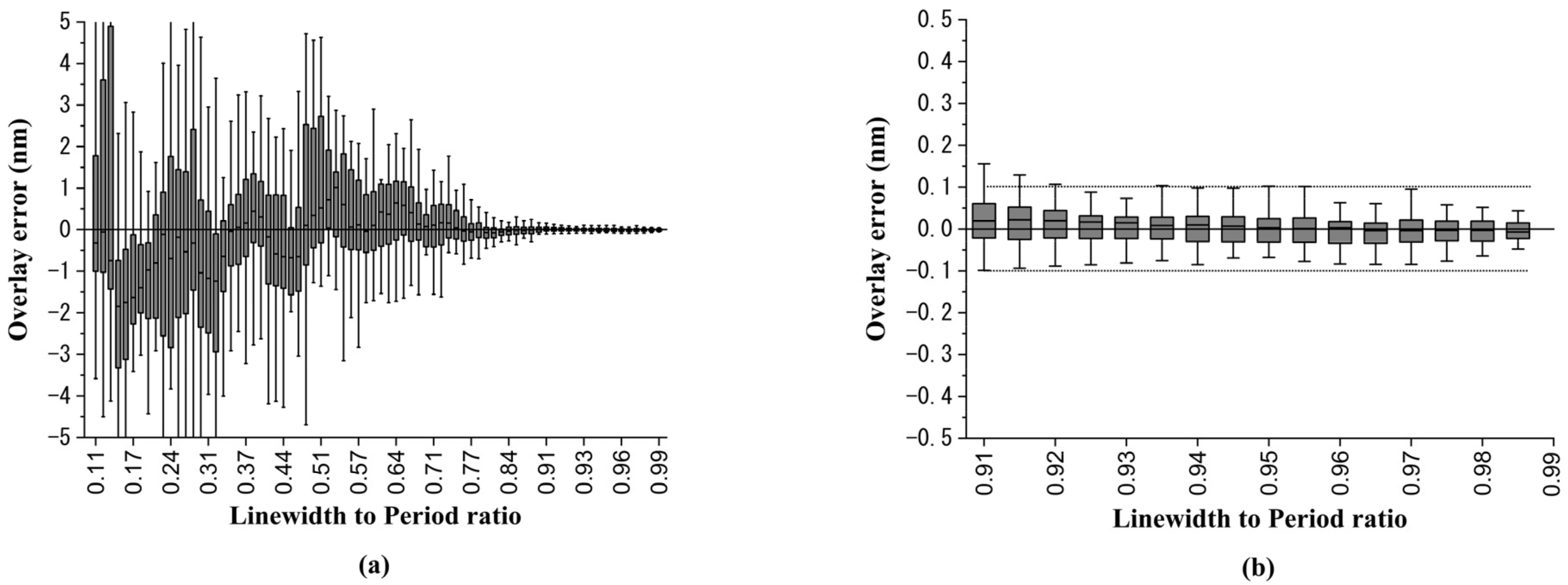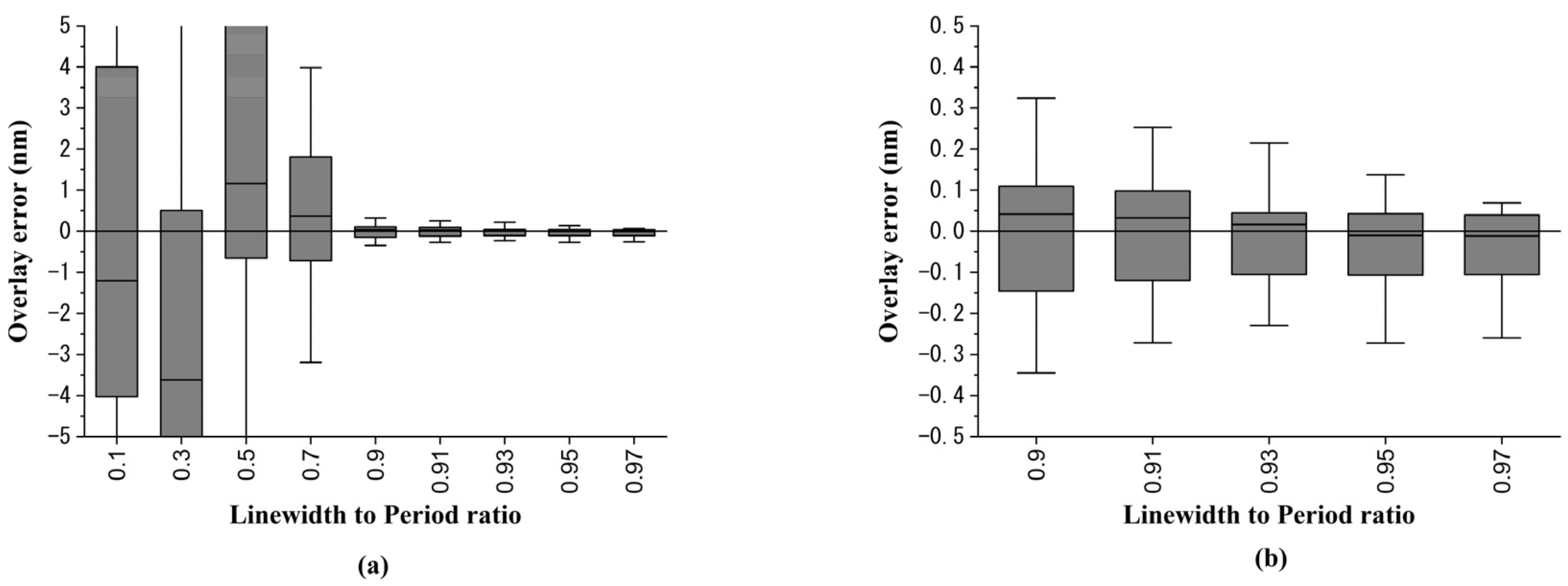Designing Highly Precise Overlay Targets for Asymmetric Sidewall Structures Using Quasi-Periodic Line Widths and Finite-Difference Time-Domain Simulation
Abstract
:1. Introduction
2. Principle
2.1. Principle of Diffraction-Based Overlay (DBO) Measurement
2.2. Asymmetric Intensity Calculation for Sidewall Asymmetric Bottom Grating Structure by the Grating-Separation Model
2.3. Quasi-Period Linewidth Design
3. Simulation Setup and the Simulated Asymmetric Structure
3.1. Simulation Conditions Setup
3.2. Sidewall Asymmetric Structure Setup for Simulation
4. Simulation Results and Discussions
4.1. Simple Sidewall Angle Asymmetric Structure
4.2. Film Thickness Variation Simulation
4.3. Two-Level Sidewall Asymmetric Bottom Grating Structure
5. Conclusions
Author Contributions
Funding
Institutional Review Board Statement
Informed Consent Statement
Data Availability Statement
Acknowledgments
Conflicts of Interest
References
- Mike, A.; Daniel, K.; Vladimir, L.; Joel, S.; Alex, K. Diffraction order control in overlay metrology: A review of the roadmap options. Proc. SPIE 2008, 6922, 692202. [Google Scholar]
- Ke, C.M.; Huang, G.T.; Huang, J.; Rita, L. Accuracy of diffraction-based and image-based overlay. Proc. SPIE 2011, 7971, 79711E. [Google Scholar]
- Wang, N.; Li, Y.; Sha, F.; He, Y. Sub-nanometer misalignment sensing for lithography with structured illumination. Opt. Lett. 2022, 47, 4427–4430. [Google Scholar] [CrossRef] [PubMed]
- Shang, E.; Ding, Y.; Chen, W.; Hu, S.; Chen, S. The Effect of Fin Structure in 5 nm FinFET Technology. J. Microelectron. Manuf. 2019, 2, 19020405. [Google Scholar] [CrossRef]
- Dettoni, F.; Shapoval, T.; Bouyssou, R.; Itzkovich, T.; Haupt, R.; Dezauzier, C. Image based overlay measurement improvements of 28nm FD-SOI CMOS front-end critical steps. Proc. SPIE 2017, 10145, 101450C. [Google Scholar]
- Dixit, D.; Keller, N.; Lifshitz, Y.; Kagalwala, T.; Elia, A.; Todi, V.; Fronheiser, J.; Vaid, A. Nonconventional applications of Mueller matrix-based scatterometry for advanced technology nodes. J. Micro/Nanolitho. MEMS MOEMS 2018, 17, 034001. [Google Scholar] [CrossRef]
- Ko, C.H.; Ku, Y.S. OVL measurement using angular scatterometer for the capability of integrated metrology. Opt. Express 2006, 14, 6001–6010. [Google Scholar] [CrossRef]
- Fallet, C.; Novikova, T.; Foldyna, M.; Manhas, S.; Ibrahim, B.H.; Martino, A.D.; Vannuffel, C.; Constancias, C. Overlay measurements by Mueller polarimetry in back focal plane. J. Micro/Nanolitho. MEMS MOEMS 2011, 10, 033017. [Google Scholar] [CrossRef]
- Yang, W.; Webb, R.L.; Rabello, S.; Hu, J.; Lin, J.Y.; Heaton, J.D.; Dusa, M.V.; Boef, A.J.; Schaar, M.; Hunter, A. Novel diffraction-based spectroscopic method for overlay metrology. Proc. SPIE 2003, 5038, 200–207. [Google Scholar]
- Messinis, C.; Schaijk, T.T.M.; Pandey, N.; Tenner, V.T.; Witte, S.; Boer, J.F.; Boef, A. Diffraction-based overlay metrology using angular-multiplexed acquisition of dark-field digital holograms. Opt. Express 2020, 28, 37419–37435. [Google Scholar] [CrossRef]
- Leray, P.; Cheng, S.; Kandel, D.; Adel, M.; Marchelli, A.; Vakshtein, I.; Vasconi, M.; Salski, B. Diffraction based overlay metrology: Accuracy and performance on front end stack. Proc. SPIE 2008, 6922, 69220O. [Google Scholar]
- Nam, Y.S.; Kim, S.; Shin, J.H.; Choi, Y.S.; Yun, S.H.; Kim, Y.H.; Shin, S.W.; Kong, J.H.; Kang, Y.S.; Ha, H.H. Overlay improvement methods with diffraction based overlay and integrated metrology. Proc. SPIE 2015, 9426, 942612. [Google Scholar]
- Hsieh, H.C. Improving the cross-layer misalignment measurement accuracy by pattern-center shift induced error calibration. Opt. Lasers Eng. 2022, 155, 107051. [Google Scholar] [CrossRef]
- Huang, H.T.; Raghavendra, G.; Sezginer, A.; Johnson, K.; Stanke, F.E.; Zimmerman, M.L.; Cheung, C.; Miyagi, M.; Singh, B. Scatterometry-based overlay metrology. Proc. SPIE 2003, 5038, 126–137. [Google Scholar]
- Bringoltz, B.; Marciano, T.; Yaziv, T.; DeLeeuw, Y.; Klein, D.; Feler, Y.; Adam, I.; Gurevich, E.; Sella, N.; Lindenfeld, Z.; et al. Accuracy in optical overlay metrology. Proc. SPIE 2016, 9778, 97781H. [Google Scholar]
- Kandel, D.; Levinski, V.; Sapiens, N.; Cohen, G.; Amit, E.; Klein, D.; Vakshtein, I. Overlay accuracy fundamentals. Proc. SPIE 2012, 8324, 832417. [Google Scholar]
- Wang, N.; Jiang, W.; Zhang, Y. Misalignment sensing with a moiré beat signal for nanolithography. Appl. Opt. 2020, 45, 1762–1765. [Google Scholar] [CrossRef] [PubMed]
- Bhattacharyya, K.; Noot, M.; Chang, H.; Liao, S.; Chang, K.; Gosali, B.; Su, E.; Wang, C.; Boef, A.; Fouquet, C.; et al. Multi-wavelength approach towards on-product overlay accuracy and robustness. Proc. SPIE 2018, 10585, 105851F. [Google Scholar]
- Shi, Y.; Li, K.; Chen, X.; Wang, P.; Gu, H.; Jiang, H.; Zhang, C.; Liu, S. Multiobjective optimization for target design in diffraction-based overlay metrology. Appl. Opt. 2020, 59, 2897–2905. [Google Scholar] [CrossRef] [PubMed]
- Hsieh, H.C.; Cheng, J.M.; Yeh, Y.C. Optimized wavelength selection for diffraction-based overlay measurement by minimum asymmetry factor variation with finite-difference time-domain simulation. Appl. Opt. 2022, 61, 1389–1397. [Google Scholar] [CrossRef]
- Hsieh, H.C.; Chen, Y.L.; Wu, W.T.; Chang, W.Y.; Su, D.C. Full-field refractive index distribution measurement of a gradient-index lens with heterodyne interferometry. Meas. Sci. Technol. 2010, 21, 105310. [Google Scholar] [CrossRef]
- Lin, J.Y.; Chen, K.H.; Chen, J.H. Optical method for measuring optical rotation angle and refractive index of chiral solution. Appl. Opt. 2007, 46, 8134–8139. [Google Scholar] [CrossRef] [PubMed]
- Hsu, C.C.; Chen, H.; Chiang, C.W.; Chang, Y.W. Dual displacement resolution encoder by integrating single holographic grating sensor and heterodyne interferometry. Opt. Express 2017, 25, 30189–30202. [Google Scholar] [CrossRef]
- Hsu, C.C.; Sung, Y.Y.; Lin, Z.R.; Kao, M.C. Prototype of a compact displacement sensor with a holographic diffraction grating. Opt. Laser Technol. 2013, 48, 200–205. [Google Scholar] [CrossRef]
- Stevenson, W.H. Optical Frequency Shifting by Means of a Rotating Diffraction Grating. Appl. Opt. 1970, 9, 649–652. [Google Scholar] [CrossRef] [PubMed]
- Demarest, F.C. High-resolution, high-speed, low data age uncertainty, heterodyne displacement measuring interferometer electronics. Meas. Sci. Technol. 1998, 9, 1024–1030. [Google Scholar] [CrossRef]
- Bao, Y.; Nan, F.; Yan, J.; Yang, X.; Qui, C.W.; Li, B. Observation of full-parameter Jones matrix in bilayer metasurface. Nat. Commun. 2022, 13, 7550. [Google Scholar] [CrossRef]
- Available online: https://refractiveindex.info/?shelf=other&book=copolymer_resists&page=Microchem85mEL (accessed on 22 July 2022).











Disclaimer/Publisher’s Note: The statements, opinions and data contained in all publications are solely those of the individual author(s) and contributor(s) and not of MDPI and/or the editor(s). MDPI and/or the editor(s) disclaim responsibility for any injury to people or property resulting from any ideas, methods, instructions or products referred to in the content. |
© 2023 by the authors. Licensee MDPI, Basel, Switzerland. This article is an open access article distributed under the terms and conditions of the Creative Commons Attribution (CC BY) license (https://creativecommons.org/licenses/by/4.0/).
Share and Cite
Hsieh, H.-C.; Wu, M.-R.; Huang, X.-T. Designing Highly Precise Overlay Targets for Asymmetric Sidewall Structures Using Quasi-Periodic Line Widths and Finite-Difference Time-Domain Simulation. Sensors 2023, 23, 4482. https://doi.org/10.3390/s23094482
Hsieh H-C, Wu M-R, Huang X-T. Designing Highly Precise Overlay Targets for Asymmetric Sidewall Structures Using Quasi-Periodic Line Widths and Finite-Difference Time-Domain Simulation. Sensors. 2023; 23(9):4482. https://doi.org/10.3390/s23094482
Chicago/Turabian StyleHsieh, Hung-Chih, Meng-Rong Wu, and Xiang-Ting Huang. 2023. "Designing Highly Precise Overlay Targets for Asymmetric Sidewall Structures Using Quasi-Periodic Line Widths and Finite-Difference Time-Domain Simulation" Sensors 23, no. 9: 4482. https://doi.org/10.3390/s23094482
APA StyleHsieh, H.-C., Wu, M.-R., & Huang, X.-T. (2023). Designing Highly Precise Overlay Targets for Asymmetric Sidewall Structures Using Quasi-Periodic Line Widths and Finite-Difference Time-Domain Simulation. Sensors, 23(9), 4482. https://doi.org/10.3390/s23094482




